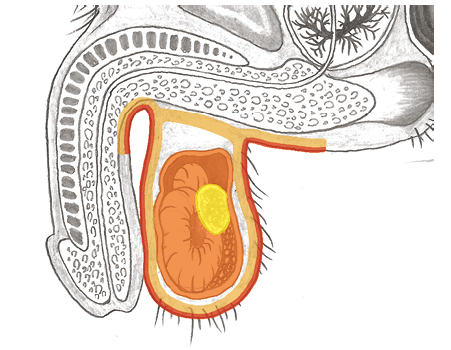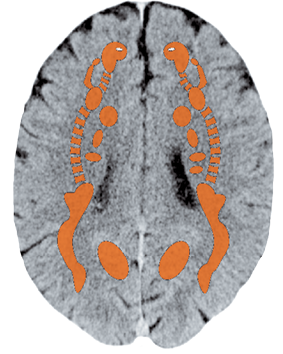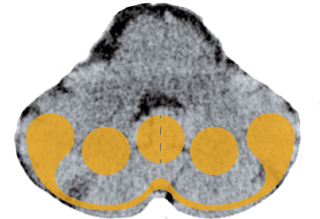In cooperation with Björn, it is splitted on "Disease is Different" into the sections by organ systems and combined with the real cases of our international testimonial / report archive of the related organ system.
TESTICLES
The two male testicles (testes) are contained in a sack called the scrotum. They produce testosterone (male sex hormone) and male germ cells (sperm).
The tubes that lead from the testicles, i.e., the epididymis and the deferent ducts (vas deferens), are used for the maturation and temporary storage of sperm.
Peritoneum
of the Scrotum
Attack against
the testicles

Testicles
Loss conflict
Teratoma
“Special Tumor“
Severe-loss conflict

Testicular tumor (testicular cancer, seminoma, Leydig cell tumor)1
Inadequate functioning of the gonads (testicular hypogonadism,
Klinefelter syndrome)
Same SBS as above.
| Example |  Just before the age of four, a boy suffers a loss conflict concerning his parents (more related to the father). This was the result of his mother leaving his father following a hysterical scene. Despite many attempts at therapy over the years, the boy didn’t come into healing. At the age of 12, when the boy’s mother finally asked her son for forgiveness, he experienced a complete resolution. At the end of a 9-month healing phase, his voice changed and he grew a beard within two weeks. (Archive Antje Scherret) Just before the age of four, a boy suffers a loss conflict concerning his parents (more related to the father). This was the result of his mother leaving his father following a hysterical scene. Despite many attempts at therapy over the years, the boy didn’t come into healing. At the age of 12, when the boy’s mother finally asked her son for forgiveness, he experienced a complete resolution. At the end of a 9-month healing phase, his voice changed and he grew a beard within two weeks. (Archive Antje Scherret) |
|---|---|
| Phase | Conflict-active phase: degradation of testicular tissue (necrosis) > drop in testosterone levels > reduction of fertility due to lower production of sperm cells (oligospermia). Usually inadequate functioning is linked to smaller testicles (testicular hypoplasia) = persistent, active conflict. |
| Note | In the repair phase, one can expect a smaller or larger tumor. The poor functioning can also come from a deficiency or excess of another hormone, for instance a deficiency of gonadotropin or excess of estrogen or cortisone. (Perform a blood-hormone test). |
| Therapy | Determine the conflict or trigger(s) and resolve them in real life if possible. Questions: see above. Guiding principles: “I know there is a reason for my loss.“ “I will make the best of it and carry on in peace.“ Strength training or martial arts. High-quality proteins, e.g., eggs, honey, flower pollen, royal jelly. For testosterone levels, consider nature-identical progesterone and perhaps testosterone, taken short-term. Caution by younger patients: The goal is to stimulate the body‘s own hormone production; dependency on hormone replacements is harmful > short-term therapy only. Bioidentical hormones following the findings of Dr. Lee, Dr. Platt, Dr. Lenard and Dr. Rimkus. Natural testosterone in ginseng root, damiana (Turnera diffusa) (tea, tablets), maca (Lepidium meyenii) (powder), yohimbe. Borax internally. Cod liver oil (see p. 68). These suggestions are also valid for lack of drive due to testosterone shortage. |
Undescended testicles, sliding, rocking, walking testicles
The testicles are formed in the abdomen during embryonic development and usually migrate down into the scrotum in the seventh month of pregnancy.
If they do not, the condition is called undescended testicles.
In 75% of cases, the testicles descend, during the first year of life by themselves.
Undescended testicles is, along with other symptoms such as not fully developed lungs, a sign of immaturity in infants.
If the testicles do not come down after more than a year and the child is otherwise developing normally, the following conflict may exist:
| Conflict | 1. According to Frauenkron-Hoffmann: this is often a proxy conflict for someone from their own family who may not be allowed to act out or show masculinity. May not be manly or want to be a man (similar to phimosis (inability to retract foreskin)). 2. Loss conflict (see: p.311). |
|---|---|
| Examples | ➜ An ancestor was raped and now she hates all men. ➜ A man in the family has not resolved the issue of his gender in general or sexual orientation (e.g. forbidden or concealed homosexuality).  Substitute loss conflict: At the age of 4, a boy, whose testicles had descended normally, suddenly developed a pendulum testicle – just like his father. His father had suffered a loss conflict at the age of 9 when his mother, the boy’s grandmother, died in an accident. After the accident, he and his sister had to live with their father and stepmother – their parents were divorced. (Archive Antje Scherret) Substitute loss conflict: At the age of 4, a boy, whose testicles had descended normally, suddenly developed a pendulum testicle – just like his father. His father had suffered a loss conflict at the age of 9 when his mother, the boy’s grandmother, died in an accident. After the accident, he and his sister had to live with their father and stepmother – their parents were divorced. (Archive Antje Scherret) |
| Bio. function | One doesn’t want to be a man, the genitalia (testicles) remain hidden, are not shown outwardly. Reduced ability to reproduce. “If male, then at least infertile.“ |
| Questions | Who does the child reflect? Who doesn’t want to be/isn’t allowed to be a man? (Usually a male ancestor). Why is this particular child carrying this conflict? Did ancestors also have undescended testicles/phimosis? (Indication of generational issue). Which specific changes do we want to achieve? (On the inside and outside). |
| Therapy | Find out who the child reflects. Then, try to heal the issue within the family. If necessary, use the therapy proposals above. If necessary, CM: hormone therapy or surgery. |
1 See Dr. Hamer, Charts pp. 69, 80

Hydrocele (fluid in the testicular pouch) with closed inguinal canal
Before or after birth, the testicles move down from the abdominal cavity through the inguinal canal into the scrotum. Normally, the inguinal canal closes thereafter.
| Conflict | Attack on the testicles + syndrome. Most common attack: sterilization (vasectomy) or OP. |
|---|---|
| Examples | ➜ A boy receives a blow to the testicles. ➜ Verbal or perceived attack: “I‘ll have your balls!“ “A kick in the nuts!”  Hydrocele was diagnosed in a 4-year-old boy – the doctors wanted to operate. It came to light that the parents were having a disagreement over the last few months. The mother wanted the father to have a vasectomy. = Substitute attack to the testicles conflict. As therapy, the parents should come to an agreement, thank the child and explain to him that he doesn’t need to carry this problem for them anymore. Two days after this explanation and gratitude, the testicles became inflamed and swelled even more (= repair phase). The parents again refused an OP. 10 days later, the hydrocele was completely gone without any surgical procedure. (Archive B. Eybl) Hydrocele was diagnosed in a 4-year-old boy – the doctors wanted to operate. It came to light that the parents were having a disagreement over the last few months. The mother wanted the father to have a vasectomy. = Substitute attack to the testicles conflict. As therapy, the parents should come to an agreement, thank the child and explain to him that he doesn’t need to carry this problem for them anymore. Two days after this explanation and gratitude, the testicles became inflamed and swelled even more (= repair phase). The parents again refused an OP. 10 days later, the hydrocele was completely gone without any surgical procedure. (Archive B. Eybl) A married man got a vasectomy and immediately regretted his decision after the operation (thinking about it day and night). Thereafter, whenever he had an argument with his partner, he associated it with his vasectomy or his testicles. Over the years, he developed a fist-sized swollen testicle (hydrocele) on his partner side = chronic persistent conflict. (Archive B. Eybl) A married man got a vasectomy and immediately regretted his decision after the operation (thinking about it day and night). Thereafter, whenever he had an argument with his partner, he associated it with his vasectomy or his testicles. Over the years, he developed a fist-sized swollen testicle (hydrocele) on his partner side = chronic persistent conflict. (Archive B. Eybl) |
| Conflict-active | Conflict–active Cell proliferation (mesothelium). |
| Bio. function | Thickening of the testicular peritoneum, in order to better protect the testicles from attack. |
| Repair phase | Caseating, tubercular degradation of the tumor, accumulation of fluid = hydrocele. This usually occurs due to chronic conflict activity, but only in conjunction with syndrome. |
| Note | A hydrocele can also come from an injury (blow, contusion) or an inflammation of the testicles (see testicular tumor p. 311). |
| Therapy | See pp. 312 and 277. The attack conflict is resolved. Support the healing. Avoid recurrences. Resolve any active refugee conflict (see: p.279). Avoid punctures due to conflict potential. Lymph drainages (see p. 68). OP if necessary. |
Hydrocele (fluid in the testicular pouch) with open inguinal canal
If the closure of the inguinal canal is incomplete, fluid from the pelvic cavity can leak into the scrotum.
Possible causes
• Peritoneum: “attack to the abdomen” in the repair phase: collection of abdominal fluid (ascites) that flows into the scrotum (see: p.259).
• Scrotum – peritoneum “attack to the testicles” in the repair phase: the fluid arises in the scrotum itself (see 313).
• Abdominal organs such as the intestines, liver or pancreas in healing: fluid is produced by every inflammation, but if the inguinal canal is open, the fluid can leak into the scrotum.
Note
Because this illness usually affects newborns, CM calls it “congenital hydrocele;“ always in combination with syndrome (see: p.277).
Therapy
• Children: substitution conflict.
• Determine and resolve the conflict and the causal conditioning (also refugee conflict).
• Lymph drainages.
• Hydrocele usually resolves spontaneously. > OP if necessary after first waiting and observing.
Germ cell tumor (teratoma)
| Conflict | Painful loss of a person or animal. Similar to teratoma of the ovaries (see: p.295). |
|---|
All experience reports on the organ system “Testicles” from the International Report Archive:


